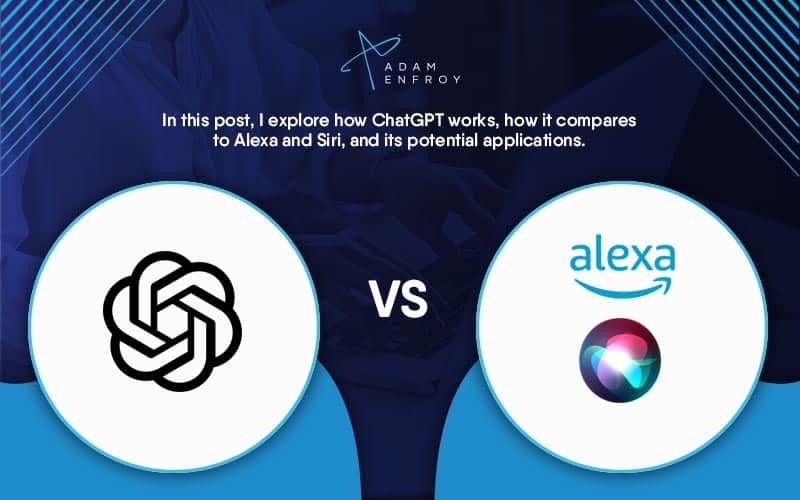Comparing ChatGPT vs. Alexa and Siri: Which One Stands Out?

With the advent of virtual assistants like Alexa and Siri, we have grown accustomed to using voice technology to communicate with machines.
From turning on the lights to setting our morning alarms, rare are the moments when our voice doesn’t play a part.
We can now also have full-blown conversations with a robot.
Enter ChatGPT – an advanced conversational AI tool that can remember user interactions and offer far more comprehensive responses than other AI tools.
In this blog post, I’ll explore how ChatGPT works, how it compares to popular voice assistants like Alexa and Siri, and the potential applications of this powerful new technology.
How ChatGPT Works
ChatGPT relies on deep learning algorithms and natural language processing (NLP) models.
It’s trained on large datasets of conversations between humans and machines, allowing it to detect patterns in text-based input accurately.
When you ask a question or make a request, ChatGPT will analyze your query and generate a response based on what it has learned from its training data.
ChatGPT also offers a more extensive database that allows for deeper dialogue and more accurate responses than Alexa or Siri are currently capable of providing.
At its core, ChatGPT is a chatbot software based on OpenAI’s GPT-3.
With this platform, you can also use voice input to speak instructions clearly into your device’s microphone, and ChatGPT will understand what you’re saying.
As a result, the ChatGPT language model is quickly becoming a significant player in the ecosystem of personal assistants.
Additionally, because it understands nuance better than other AI assistants, it can provide more specific answers tailored to your individual needs.
Furthermore, with its more extensive database, you can ask multiple related questions in one go without having to re-explain yourself each time.
Another key benefit of using ChatGPT is that users can use it on many different platforms.
Whether you’re on your phone, a tablet, or a web browser, you can interact with ChatGPT.
This functionality is something Alexa or Siri cannot yet do.
ChatGPT’s AI technology also allows it to carry out complex tasks typically requiring manual labor.
For example, its auto-programming feature enables it to develop code for software applications with human-like accuracy.
It can also generate natural language from abstract concepts and provide detailed answers to questions posed via text or voice input.
In addition, its advanced machine learning algorithms allow it to create high-quality papers on any topic with minimal effort from the user.
Amazon Alexa and Siri
Let’s now consider how these two tools work.
Amazon Alexa
With the smart home revolution in full swing, Amazon Alexa has quickly become one of the most popular voice assistants.
Alexa can recognize your voice and get things done faster, allowing you to set reminders, play music, and answer questions.
The Alexa team works hard behind the scenes collecting user feedback to continually refine their service and develop increasingly sophisticated models for handling complex questions.
For example, you may ask Alexa, “What restaurants are nearby?”.
Then, the software will respond with a list of restaurants within a certain radius of your current location.
Or you can ask, “Can you play some music?” and it will start streaming music from your preferred streaming service.
Additionally, Alexa can control your home devices like lights, thermostats, security cameras, etc.
This ability makes it one of the most advanced voice assistants on the market today.
Being a smart speaker, Alexa is also compatible with many devices, such as Amazon Echo, Fire TV, and many more.
Siri
Apple’s Siri is another leading digital voice assistant service available today.
For those with an Apple iOS device, it can answer questions, play music, search the web for information, and perform basic tasks like setting reminders or sending texts/emails.
Enabling various shortcuts and voice commands, Siri has proven to be an incredibly convenient way to keep our lives and tasks organized.
Siri also works well with HomeKit, so you can control your home devices using voice commands.
However, Siri has fewer features than Alexa and isn’t as accurate in understanding more complex questions.
Regarding its voice control, you can expect to see continued improvement in Siri’s capabilities, and it will soon be able to compete with Alexa on a more level playing field.
While these two popular services use words or phrases to communicate, ChatGPT takes a more advanced approach.
By utilizing Natural Language Processing (NLP) and Machine Learning (ML) technologies, ChatGPT can understand and respond to requests with much higher accuracy.
It’s worth mentioning that Google Assistant is very similar to Alexa and Siri in that it offers many of the same features and use cases.
Google Assistant runs on various Android devices, and one can use it to control their home devices and perform other tasks.
Samsung also has its own Bixby assistant available on its smartphones, although it has not gained as much popularity as the others.
ChatGPT vs. Alexa & Siri: What’s the Difference?
While developers designed Alexa and Siri to provide quick responses to simple questions, they made ChatGPT suitable for more extended conversations involving complex topics.
For example, you can ask Alexa or Siri about the weather in your area.
They will be able to give you an answer quickly because their algorithms are great for short conversations about essential topics like the weather.
However, you can ask ChatGPT about something more complex such as the economic impact of current events on businesses in your area.
In that case, it will be able to provide a much more detailed response because its algorithms revolve around handling extended conversations.
GPT-3 Chatbot Technology
GPT-3 Chatbots are AI applications that understand users’ questions and respond accordingly.
Chatbot technology has seen a steady rise in popularity since AI has become more prevalent in everyday life.
While ChatGPT, Alexa, and Siri may all fall under the umbrella of “chatbot technology,” each platform has key differences that make them unique.
For example, Apple’s Siri and Amazon’s Alexa are built on a more basic set of algorithms optimized for providing quick answers to simple questions.
Various other companies have built their chatbots to provide specific uses.
For example, Netflix uses its chatbot to provide first-line customer support when users have questions about their account or a particular show.
Combining AI Forces
Developer Mate Marschalko attempted to combine HomeKit with ChatGPT, building what he calls the “world’s smartest HomeKit voice assistant.”
As time passes, it will be interesting to see how ChatGPT and Alexa & Siri could evolve together as they continue using AI and ML technologies.
Limitations Of Text-Based Input
AI chatbots, such as ChatGPT, Alexa, and Siri, require users to communicate through voice or text-based input, both of which can be limiting.
Text-based input relies heavily on the user’s writing ability and often fails to interpret the user’s intentions and messages accurately.
Additionally, text-based input fails to capture non-verbal cues such as facial expressions and body language, which can be essential for meaningful conversation.
This limitation of text-based input makes it difficult to accurately interpret the user’s true intentions in more complex conversations.
Voice input is slightly better in this regard.
However, these devices might still fail to grasp what a user is trying to say.
This miscommunication can happen if the language isn’t clear, the user has an accent, or the connection between the AI and the user is broken.
In addition to these limitations, AI chatbots also require access to large amounts of data.
They need such data to interpret the user’s questions accurately and provide meaningful responses.
If a chatbot has access to the necessary data, it will likely provide correct or complete answers.
This results in problematic outputs for users who depend on the accuracy of their chatbot’s responses.
Despite these limitations, AI chatbots can still be helpful in many situations.
With the correct data and programming, AI chatbots can provide accurate and helpful information to users while making conversations more efficient.
With the increasing sophistication of AI technology, chatbots’ capabilities will continue to expand and become more useful in everyday life.
The Chinese Room Thought Experiment
In 1980, philosopher John Searle proposed the Chinese Room thought experiment to demonstrate that computers cannot truly understand language.
The thought experiment imagines a person who does not speak Chinese being locked in a room with an instruction book written in English.
The person then answers questions written in Chinese based on the textbook’s information.
While computers can accurately respond to queries based on instructions from programmers, they cannot comprehend language.
Nowadays, one can argue that this experiment still holds.
Advances in AI technology have made it possible for computers to understand language on a fundamental level.
For example, ChatGPT can detect patterns in text-based input and generate responses based on its training data.
However, it is still far from having the same understanding as humans, which Searle’s thought experiment demonstrated.
As research on chatbots has been gaining more attention, the full possibilities of this technology are yet unknown.
With popular ideas such as the Chinese Room thought experiment and advances in AI technology, it is possible that chatbots could develop a deeper understanding of language and more complex conversations in the future.
As this technology continues to evolve, it will be interesting to see how far chatbot development progresses.
What Sets ChatGPT Apart From Other AI Assistants?
ChatGPT is an AI-based business assistant that can perform various tasks such as creating reports, managing customer relationships, and giving specific outputs based on set inputs.
It stands out from other AI assistants due to its ability to quickly provide detailed answers to questions.
For example, if a customer asks, “What are the best features of your product?” ChatGPT will instantly provide an answer based on its understanding of the product and its features.
It’s easier for users to quickly get the information they need without manually searching through multiple sources.
Another key advantage of using ChatGPT is its ability to integrate easily with existing software applications and systems such as CRM databases and HR software.
Businesses can leverage AI’s power without investing in additional hardware or software solutions.
It also helps automate specific processes, significantly reducing time spent on manual tasks.
Furthermore, ChatGPT gives users access to predictive analytics, which helps them better understand their customer’s needs and wants.
It can also provide insights into potential areas for improvement within their business operations.
Businesses can make informed decisions to help them achieve their goals faster and more efficiently.
As an open-API platform, ChatGPT is at the forefront of AI-driven business assistants.
ChatGPT vs. Alexa and Siri – FAQ
Does Chat GPT Generate Human-Like Responses Compared To Alexa And Siri?
Yes, ChatGPT does create answers that are similar to human conversations.
While Alexa and Siri have limited capacity to understand complex questions, ChatGPT can generate natural language responses using advanced algorithms.
Can You Use ChatGPT For Social Media Posts And Conversations?
Yes, ChatGPT can focus on social media posts and discussions.
It can understand more complex language than Alexa and Siri and generate responses similar to natural human communication.
It can also be used for customer support, answering common questions quickly and accurately.
What Exactly Is A Generative Pre-Trained Transformer?
A Generative Pre-Trained Transformer (GPT) is an advanced type of artificial intelligence (AI) technology introduced on a large set of text data.
GPTs are capable of generating high-quality, human-like responses from a given input.
One can use them for natural language processing tasks such as question-answering and conversation generation.
ChatGPT uses GPT 3.5 (the latest version of GPT before GPT 4) to generate natural language responses.
Wrap Up.
ChatGPT is a powerful and versatile open-source AI chatbot framework for creating sophisticated conversational AI.
It can create virtual agents, natural language processing models, dialogue systems, and more.
Compared to Alexa and Siri, ChatGPT can provide more text-based responses.
It can also understand complex questions with multiple parts and generate responses similar to human conversations.
While there is a time and place for using Alexa and Siri, ChatGPT provides businesses with the necessary tools to automate customer support.
This platform also helps make informed decisions that benefit their bottom line.





